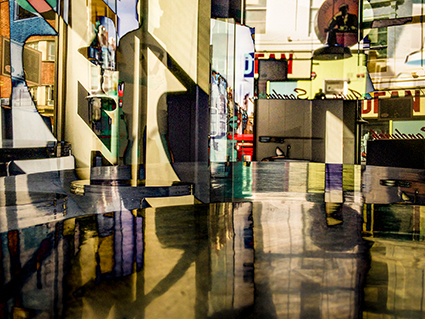
The Creative Space, Part Two
In part one of this post I imagined an inspirational photographic location – a creative space – and then looked at how different artistic disciplines might interpret that space. I ended with the question, ‘how can we enlarge the creative spaces we inhabit to energise our work?’ Let’s look at an example from last year’s workshop, using poetry.
Following an introduction looking at Japanese books illustrating haiku poems and touching on the work of Duane Michels, you are given two poems with the request to visualise them photographically. This introduces text and therefore activates both the left and the right brain.
The process of finding a hook on which to hang a photograph forces us to study the meaning in a way quite different from reading a poem in a book. It stretches our imagination, helps us think in terms of metaphors and pushes us to explore new directions. It is a simple technique but it works. The first reaction is surprise. It seems baffling but we teach tools which help conjure up images out of words . So the initial reaction is quickly followed by intrigue at the challenge and usually delight at the refreshing end result.
But is the idea of enlarging your creative space right for you? There’s an easy way to tell but you will need to set aside a few hours.
Look back over your work of say, the last two years.
Pick twenty favourite images from each of those years.
Lay them out in Bridge, run a slideshow or preferably look at postcard size prints. Review that body of work. What do you see?
Using free association, what are your strongest impressions? Here is a starter checklist;
Rational: choice of lens/camera, depth of focus, vantage point, colour palette, image composition, post processing style …etc.
Emotional: human interest, decisive moments, emotional qualities, use of analogy or metaphor … etc.

Scribble spontaneously the words which come to mind. Do it quickly and don’t hold back. We’re looking for a plentiful supply of first impressions. Then repeat for the second year. Using the mind’s natural ability to detect patterns, look for recurring themes in words and images, similarities and differences. What is the overall picture? What are the repeat patterns? Are they positive or negative? Then consider this equation:
Do you have a strong signature style which you execute consistently across different creative spaces?
Or is it that you are traveling the world basically taking similar pictures?
The question is: in short, are you in a groove or a rut?
Most of us fall somewhere between the two. And where we fall on that line tells us what we need to do next. Whatever the outcome, this is a useful exercise and I hope you benefit from it. If you like the idea of seeing how different artistic disciplines can influence your photography it is easy to try out the poetry example above with a friend.
If you’d like a more comprehensive approach to enlarging your creative space, then please check out the ‘Visual Conversations’ workshop I co-teach with Eileen McCarney Muldoon at Maine Media College in July and at the Leica Studio, Mayfair, London in August.
Visual Conversations
July 10th – 16th, Maine Media College, Rockport, USA
Aug 23rd – 25th, Leica Studio, London, UK
Do you have a strong signature style which you execute consistently across different creative spaces?
Or is it that you are traveling the world basically taking similar pictures?
The question is: in short, are you in a groove or a rut?
Most of us fall somewhere between the two. And where we fall on that line tells us what we need to do next. Whatever the outcome, this is a useful exercise and I hope you benefit from it. If you like the idea of seeing how different artistic disciplines can influence your photography it is easy to try out the poetry example above with a friend.
If you’d like a more comprehensive approach to enlarging your creative space, then please check out the ‘Visual Conversations’ workshop I co-teach with Eileen McCarney Muldoon at Maine Media College in July and at the Leica Studio, Mayfair, London in August.
Visual Conversations
July 10th – 16th, Maine Media College, Rockport, USA
Aug 23rd – 25th, Leica Studio, London, UK

If you have trouble in deciding on your best work in the first place, then check out John Paul Caponigro’s site which has a host of terrific references including a PDF called ‘Finding Your Best Work’.
Find it here.
Find it here.


No Comments